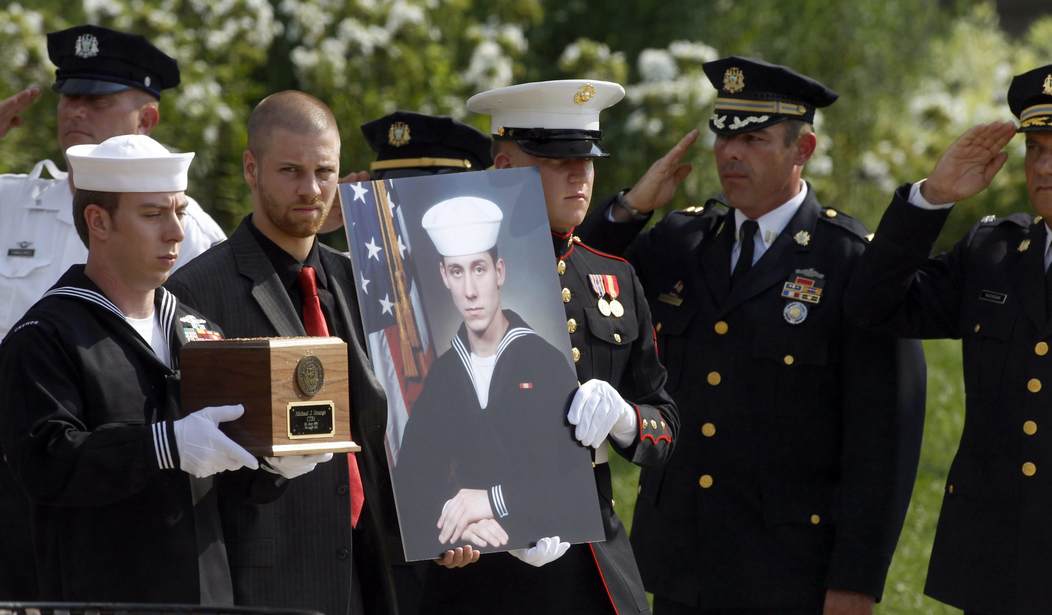The downing of a Chinook helicopter gunship (known by its call sign Extortion 17) in Afghanistan on August 6, 2011, has for years been shrouded in mystery, with the families of American fighters killed demanding answers and feeling betrayed by their government.
Considered the worst loss of American lives in a single incident in the Afghanistan theater, the crash claimed 38 lives: 25 American special operations personnel, five United States Army National Guard and Army Reserve crewmen, seven Afghan commandos, and one Afghan interpreter—as well as a U.S. military working dog. Seventeen of the U.S. Special Operations personnel killed were Navy SEALs, fifteen of whom were commandos from the Gold Squadron of the elite Naval Special Warfare Development Group (DEVGRU), better known as SEAL Team Six.
A decorated retired Air Force officer who witnessed the downing of Extortion 17 broke her silence this week, telling Circa News that the government covered up evidence that showed the tragedy could have been prevented had it not been for the Obama administration’s restrictions on the military’s rules of engagement.
Retired Air Force Capt. Joni Marquez and her crew were working the dark morning hours aboard an AC-130 gunship after being summoned to a mission she describes “as almost like a 9-1-1 type of a situation.”
The gunship was ordered to fly close-in air support above Afghanistan’s dangerous Tangi Valley, in Wardak Province, assisting troops with the Army’s 75th Ranger Regiment who were being fired on by eight heavily armed Taliban insurgents.
The Rangers had called in for assault helicopters to engage the enemy hiding among the rocky valley. The air weapons team fired on the Taliban fighters, but not all of the insurgents were killed as originally believed.
“I had the sensor operators immediately shift to the eight insurgents the helicopters had taken out,” Marquez told Circa, in her first interview about the incident. “Two were still alive.”
Marquez was the fire control officer aboard the AC-130 gunship, making sure that the sensors and weapons were aligned and allowing the crew hone in on targets.
That night it didn’t matter, because the gunship was not given permission to fire. “We had seen two of them (insurgents) moving, crawling away from the area, as to not really make a whole lot of scene,” she recalled.
Monitoring the scene from above, she relayed the scene to the ground force commander. “You have two enemy forces that are still alive,” she said. “Permission to engage.”
They were denied.
There was little left to do for Marquez and her team but simply track the two enemy insurgents with the surveillance equipment. She watched as the two moved tactically through the open field, making their way to a village where they began to rally more fighters.
Meanwhile, a CH-47 Chinook helicopter, with the call sign Extortion 17, was called into the hours-long firefight.
U.S. Central Command’s official investigation concluded that a rocket-launched grenade from a Taliban fighter hit the Chinook and sent the helicopter into a downward spin. The crash killed all 38, including thirty Americans and eight Afghans. Seventeen of the U.S. servicemen were Navy SEALs. Months before, SEALs were made famous for the killing of Osama bin Laden.
“If we would’ve been allowed to engage that night, we would’ve taken out those two men immediately,” Marquez said. She believes that had her team been allowed to fire, those deaths could have been prevented.
“They continued to essentially gain more and more force behind them because they just kept knocking on doors,” she said. “And the two personnel that initially fled ended up becoming a group of 12 people.”
Pleas and warnings from her crew to turn the Chinook back or cancel their mission went unheeded, she added.
Marquez described the horror of watching one of the SEALs ejected from the burning Chinook helicopter on her infrared monitor “as his heat signature faded from red to blue as life was slipping from his body.”
“We had to sit and watch that, and I think that was one of the hardest things that I had to do,” she said. “That man was, you know, dying on the ground.”
Marquez told Circa News that as a result of that painful experience she has been diagnosed with post-traumatic stress disorder and is in therapy.
A top secret report by the Defense Department inspector general that includes interviews with some of Marquez’s colleagues on the gunship reportedly corroborates her account of what happened.
“If we would’ve been allowed to engage that night, we would’ve taken out those two men immediately. I mean, it’s just one of those things where you know that it could’ve all been prevented,” she said sadly.
Marquez said the rules of engagement “continuously changed depending on who was in charge,” preventing soldiers from doing what they knew needed to be done.
“Ridiculous rules of engagement that basically state that you can’t shoot until being shot upon. A weapon has to be pointed, and essentially fired at you, in order for you to shoot and you have the proper clearance so that you don’t, you know, go to jail, that you’re charged with a war crime,” said Marquez.
“I won’t rest until some kind of justice is served, in a manner of either, you know, the people that were responsible for that night, for making those calls, come forward and are honest about it,” Marquez said. “I know that’s kind of a lofty goal but, if that’s something that doesn’t happen, then obviously the ROE’s to change, for them to be realistic.”
The Obama administration successfully ran out the clock on a 2015 Extortion 17 probe, refusing a judge’s order to turn over pertinent documents to Freedom Watch, a watchdog legal group led by Larry Klayman. A number of conspiracy theories sprung up surrounding Extortion 17 due to the government’s secrecy, with some of the families believing that the downing of the Chinook had been an “inside job.” A House Oversight and Reform Committee hearing in February of 2014 sought to dispel some of those rumors, but even after the hearing, some of the parents weren’t satisfied and questions still remained.
The administration’s efforts to control the narrative on Extortion 17 proved to be much more successful than their later efforts to spin away an inconvenient narrative in the wake of the terrorist attack in Benghazi, Libya, on September 11, 2012. Their malfeasance before, during, and after the deadly debacle turned out to be a major scandal for the Obama administration, yet relatively few people remember one of the most deadly attacks on Navy SEALs in U.S. history.
Bill Vaughn, the father fallen Navy SEAL Aaron Carson Vaughn, wrote “Betrayed, The Shocking True Story of Extortion 17 as told by a Navy SEAL’s Father” in 2013, in part to warn other military families about the Obama administration’s dangerous rules of engagement.
Here is a video tribute to the 30 American servicemen who lost their lives in Afghanistan when the Chinook helicopter gunship was shot down.









Join the conversation as a VIP Member